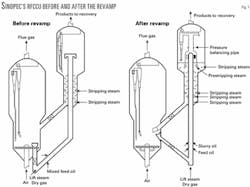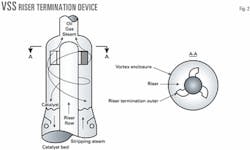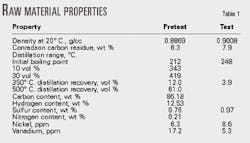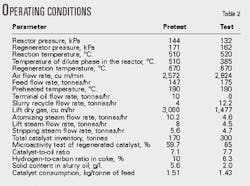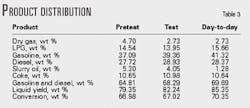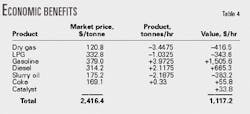Sinopec revamped its residue fluid catalytic cracking unit (RFCCU) in its Luoyang petrochemical complex (LPC) in April 2000 to enable it to process residue with more contaminants. The new design incorporated several UOP features: a VSS (vortex separation system), a multiple-stage stripper, and an Optimix spray nozzle.
Fig. 1 illustrates the changes made during the revamp.
This RFCCU was built in 1984. The economic performance of the unit suffered in 2000, however, because of increasing sulfur and metal contaminants the refinery's crude feed.
Before the revamp, Sinopec identified several problems with the unit. The T model riser terminator was not very efficient. The efficiency of the stripper was also low, and the hydrogen-to-carbon ratio of coke in spent catalyst was high. The cyclones in the reactor were a backwards design, and the solids content in the slurry oil was high. Finally, the feed spray nozzle consumed a large amount of steam, increasing the energy consumption of the RFCCU.
The revamp improved the separation efficiency of the unit by using a VSS and multiple-stage stripper. It also reduced the hydrogen content in the coke of the spent catalyst from 10 wt % to 6.3 wt %.
The new unit has a better product distribution. The yield of the dry gas dropped from 4.7 wt % to 2.7 wt %, and the yield of the light oil (including gasoline and diesel oil) improved by 3.48 wt %.
UOP improvements
The VSS is one of the most advanced riser-termination systems. UOP designed the riser-termination device of the VSS to improve the separation efficiency between the oil and the catalyst after reaction.
Fig. 2 shows the different flows of oil-gas mixture and steam. The design throws the heavier catalyst particles towards the inner wall of the VSS. The collision causes these particles to lose their momentum and rapidly changes their flow direction to the dense bed.
The oil-gas mixture rises towards the cyclones, however, through the VSS riser along with the stripping steam.
These flows tend to reduce coking in the reaction by reducing the time the oil-gas mixture spends in the reactor from 25 sec to 3 sec.
UOP's multistage stripper increases the allowable catalyst level in the stripper, which enables a higher density of catalyst in the reactor. The fluidized-state flow, developed by injecting stripping steam in five stages, allows the stripping steam to best intermingle with the oil-gas mixture.
UOP's Optimix nozzle, an atomized spray nozzle, atomizes steam to only 1.9 wt % of the feed oil. The nozzle sprays steam at a particle size that is smaller than an average feed oil particle, with narrower distribution, and with more even spraying density.
These results combine to reduce the yield of coke and dry gas.
Revamp results
The RFCCU has run well since the revamp. Unit operations are more flexible and easier than before because Sinopec can adjust the flow rate from 140 tonnes/hr to 200 tonnes/hr.
Table 1 shows raw material properties and operating conditions for pretest and test conditions.
Table 2 shows that the UOP stripper reduced the hydrogen content in coke in the spent catalyst from 10 wt % to 6.3 wt %. Thus, the stripper solved the problem of air-flow restriction to the regenerator and increased the operating range.
Table 3 shows the product distribution after the revamp. The yield of dry gas dropped from 4.7 wt % to 2.73 wt %. The yield of light oil (gasoline and diesel) increased from 64.81 wt % to 68.29 wt %.
During different tests, the Conradson carbon residue content in the raw material varied, which slightly increased the coke yield.
Under market prices and the above product distribution, the estimated economic benefit of the revamped unit in product and catalyst will increase by about $8.9 million (Table 4). This value assumes the unit runs 8,000 hr/year.
Some problems
After the revamp, Sinopec further tweaked some problems it had had with controlling the reactor catalyst level and the coke that formed on the outer wall of the VSS shell.
- Reactor-catalyst level control. Under automatic control, the catalyst level of the reactor was kept constant. When the level of the regenerator fell sharply, however, even if the reactor cyclones and regenerator worked well, some catalyst disappeared.
This condition lasted about a year, while Sinopec tried to figure out where the catalyst went. Sinopec found the fault with the catalyst level controller and coke deposits.
The level-control instrument was lagging; so Sinopec has since checked the meter and changed some related parts. Also, falling coke deposits on the outer wall of the VSS shell disturbed the measure of the catalyst level.
- Coke deposits. There were some loose and thin deposits of coke on the outer wall of the VSS shell. The main cause of this was the length of time the oil-gas mix remained in the reactor. About 2% of the oil-gas mixture, which was carried along with the catalyst from the cyclones, stayed in the reactor for 30 min.
To avoid coking on the outer wall of the VSS shell, Sinopec extended the pressure balancing pipes to the cyclone-dipleg valves. After this modification, the oil-gas mix stayed in the reactor for just 2 min.
Sinopec enlarged the diameter of the pipes to meet the pressure drop.
The authors
Zhenhui Zhao is the director of the refinery and a senior engineer at Sinopec's Luoyang petrochemical complex. He has more than 19 years' experience in FCC operation and management. He holds a BS in petrochemical engineering from Hebei Insitute, Tianjin, China.
Xiaodong Ye is chief refining engineer and a senior engineer at Sinopec's Luoyang petrochemical complex. He currently develops optimization software packages and computer simulations for the refinery. Ye has more than 12 years' experience in FCCU operation and processing design and holds a BS in chemistry from Lanzhou University, Lanzhou, Gansu, China.
Wuqing Xu is FCC operator, team leader, and unit engineer for Sinopec's LPC. He formerly worked with the catalytic reforming unit at LPC. Xu holds a BE in organic chemical engineering from East China Chemical Engineering of Technical College, Shanghai, and a masters degree in organic chemical engineering from Sinopec RIPP, Beijing.
